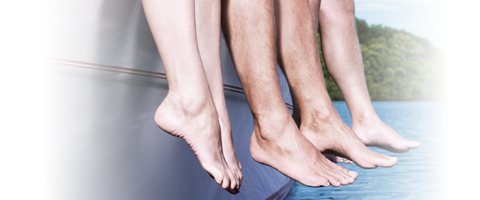You can do something for your veins in your everyday life
Find out what you can do here

Tips for taking the strain off the veins when standing at work
Standing for long periods is routine in many occupations. Standing occupations involve standing for more than 70% of the working time. This applies, for example, to sales personnel and workers in the wholesale trade, hairdressers, kitchen and catering staff, and healthcare workers (for example, operating room staff). In the long term, standing can cause health problems, in extreme cases even herniated discs and inflammation of the veins.
When standing for long periods, there is no alternating activity of the muscle groups, so that more strain is put upon certain tendons, ligaments, and joints than on others. The muscles may react with cramps and stiffness. As a result, the spine, for example, is no longer held in the right posture. And the veins too may suffer when standing for long periods. The blood no longer flows as easily from the legs back to the heart, as the muscle pump needs movement to function optimally.
Exercise promotes the flow of blood from the legs and strengthens the “muscle corset” of the spine.
Even with minor efforts at the workplace, you can do something for your body.
The most essential thing with a standing occupation is to move around sufficiently – not only after work, but also during the working day.
- Sporting activities in leisure time compensate for standing for long periods. Walking, hiking, cycling, and swimming are particularly good for the veins. But you should also try to fit in at least 30 minutes moderate exercise during the working day.
- Use every opportunity to move around and change your posture as often as possible.
- Small-scale exercises, such as walking on the spot and on tiptoe, can be done at regular intervals and you can also try and find time to fit in the vein exercises.
- Put your feet up now and again during breaks or whenever possible, in order to take the strain off your veins.
- Access to seating can also relieve the veins. This does not require sophisticated seating, a simple chair or stool is often all that is needed for you to sit down for a brief moment. If this is not possible, standing aids can be used.
- Always try to stand up straight so that your weight is optimally distributed over the body and stand with the feet apart at about the width of the hips.
- Wearing appropriate shoes is extremely important if you have to stand for long periods at work. Do not wear high heels (not more than 4 cm). Make sure that the shoes are comfortable, have enough room for your toes, and a soft cushioned sole. If you have a long working day, it is advisable to have a second pair of shoes – a change of shoes makes the feet feel better and can make quite a difference.
- In some cases, it is worthwhile wearing compression stockings.
If you follow all this advice, you are certainly doing your best to avoid the complications of having to stand for long periods.
